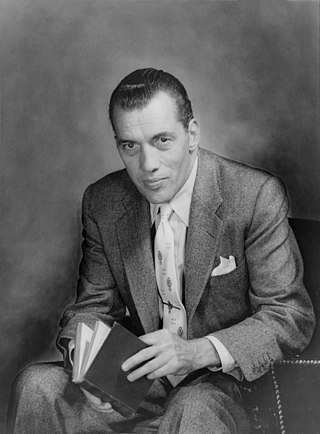
Edward Vincent Sullivan was an American television host, impresario, sports and entertainment reporter, and syndicated columnist for the New York Daily News and the Chicago Tribune New York News Syndicate. He was the creator and host of the television variety program The Toast of the Town, which in 1955 was renamed The Ed Sullivan Show. Broadcast from 1948 to 1971, it set a record as the longest-running variety show in U.S. broadcast history. "It was, by almost any measure, the last great American TV show", said television critic David Hinckley. "It's one of our fondest, dearest pop culture memories."
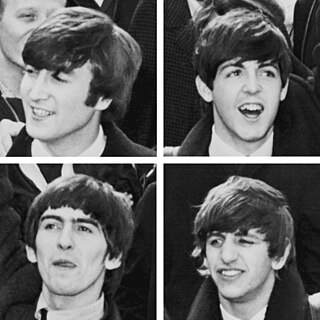
The Beatles were an English rock band formed in Liverpool in 1960, comprising John Lennon, Paul McCartney, George Harrison and Ringo Starr. They are regarded as the most influential band of all time and were integral to the development of 1960s counterculture and the recognition of popular music as an art form. Rooted in skiffle, beat and 1950s rock 'n' roll, their sound incorporated elements of classical music and traditional pop in innovative ways. The band also explored music styles ranging from folk and Indian music to psychedelia and hard rock. As pioneers in recording, songwriting and artistic presentation, the Beatles revolutionized many aspects of the music industry and were often publicized as leaders of the era's youth and sociocultural movements.
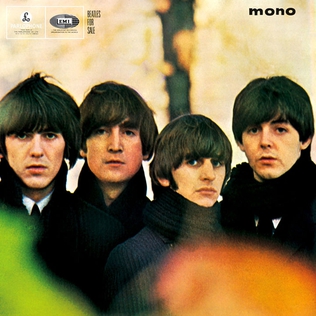
Beatles for Sale is the fourth studio album by the English rock band the Beatles. It was released on 4 December 1964 in the United Kingdom on EMI's Parlophone label. The album marked a departure from the upbeat tone that had characterised the Beatles' previous work, partly due to the band's exhaustion after a series of tours that had established them as a worldwide phenomenon in 1964. Beatles for Sale was not widely available in the US until 1987, when the Beatles' catalogue was standardised for release on CD. Instead, eight of the album's fourteen tracks appeared on Capitol Records' concurrent release, Beatles '65, issued in North America only.

The Ed Sullivan Show is an American television variety show that ran on CBS from June 20, 1948, to March 28, 1971, and was hosted by New York entertainment columnist Ed Sullivan. It was replaced in September 1971 by the CBS Sunday Night Movie.

"Get Back" is a song recorded by the English rock band the Beatles and Billy Preston, written by Paul McCartney, and credited to the Lennon–McCartney partnership. It was originally released as a single on 11 April 1969 and credited to "The Beatles with Billy Preston". The song is one of the few examples of John Lennon featuring prominently as lead guitarist. The album version of this song contains a different mix that features a studio chat between Paul McCartney and John Lennon at the beginning, which lasts for 20 seconds before the song begins, also omitting the coda featured in the single version, and with a final dialogue taken from the Beatles' rooftop concert. This version became the closing track of Let It Be (1970), which was released just after the group split up. The single version was later issued on the compilation albums 1967–1970, 20 Greatest Hits, Past Masters, and 1.

A Hard Day's Night is a 1964 musical comedy film starring the English rock band the Beatles—John Lennon, Paul McCartney, George Harrison and Ringo Starr—during the height of Beatlemania. Directed by Richard Lester, it was written by Alun Owen and originally released by United Artists. The film portrays 36 hours in the lives of the group as they prepare for a television performance.
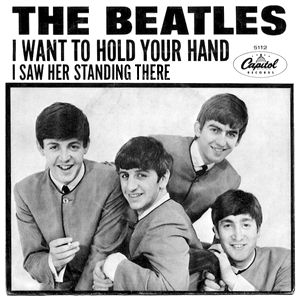
"I Want to Hold Your Hand" is a song by the English rock band the Beatles, written by John Lennon and Paul McCartney. Recorded on 17 October 1963 and released on 29 November 1963 in the United Kingdom, it was the first Beatles record to be made using four-track recording equipment.

"She Loves You" is a song by the English rock band the Beatles, written by John Lennon and Paul McCartney and released as a single in the United Kingdom on 23 August 1963. The single set and surpassed several sales records in the United Kingdom charts, and set a record in the United States as one of the five Beatles songs that held the top five positions in the charts simultaneously, on 4 April 1964. It remains the band's best-selling single in the UK and was the top-selling single of the 1960s there by any artist.

Beatlemania was the fanaticism surrounding the English rock band the Beatles from 1963 to 1966. The group's popularity grew in the United Kingdom in late 1963, propelled by the singles "Please Please Me", "From Me to You" and "She Loves You". By October, the British press adopted the term "Beatlemania" to describe the scenes of adulation that attended the band's concert performances. By 22 February 1964, the Beatles held both the number one and number two spots on the Billboard Hot 100, with "I Want to Hold Your Hand" and "She Loves You", respectively. Their world tours were characterised by the same levels of hysteria and high-pitched screaming by female fans, both at concerts and during the group's travels between venues. Commentators likened the intensity of this adulation to a religious fervour and to a female masturbation fantasy. Among the displays of deity-like worship, fans would approach the band in the belief that they possessed supernatural healing powers.
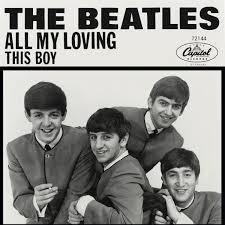
"All My Loving" is a song by the English rock band the Beatles, from their second UK album With the Beatles (1963). It was written by Paul McCartney, and produced by George Martin. Though not officially released as a single in the United Kingdom or the United States, the song drew considerable radio airplay, prompting EMI to issue it as the title track of an EP. The song was released as a single in Canada, where it became a number one hit. The Canadian single was imported into the US in enough quantities to peak at number 45 on the US Billboard Hot 100 in April 1964.

"Boys" is a song written by Luther Dixon and Wes Farrell, originally recorded by the Shirelles at Bell Sound Studios in New York City and released as the B-side of their "Will You Love Me Tomorrow" single in November 1960. It was recorded more than two years later by the Beatles and included on their debut album in the United Kingdom, Please Please Me (1963).
Music television is a type of television programming which focuses predominantly on playing music videos from recording artists, usually on dedicated television channels broadcasting on satellite, cable, or Streaming Platforms.
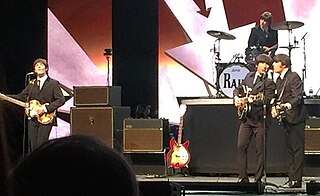
Rain: A Tribute to the Beatles, styled RAIN, is a Beatles tribute and later a theatrical production. Rain gives audiences the experience of seeing Beatles' songs performed live that were never done so by the band itself. It predates the popular Broadway show Beatlemania by several years. Rain has played Broadway, and toured for years.

The Beatles were an English rock band formed in Liverpool in 1960. With a line-up comprising John Lennon, Paul McCartney, George Harrison and Ringo Starr, they are commonly regarded as the most influential band of all time. Between 1964 and 1970, they appeared in five major motion pictures, beginning with A Hard Day's Night (1964) and ending with Let It Be (1970). From late 1965 to 1969, the group also appeared in several promotional films for their singles, which have been credited with anticipating music videos and the rise of MTV in the 1980s.
The Beatles Anthology is a documentary television series on the career of the Beatles. It was broadcast on UK television in six parts on ITV between 26 November and 31 December 1995, while in the United States it was seen as three feature-length episodes on ABC between 19 and 23 November 1995. It was released in greatly expanded form as an eight-volume VHS set and an eight-disc LaserDisc set on 5 September 1996. The series was re-released on DVD in 2003, with an 81-minute special-features disc.
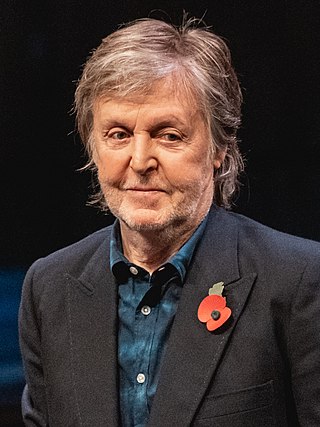
Sir James Paul McCartney is an English singer, songwriter and musician who gained worldwide fame with the Beatles, for whom he played bass guitar and shared primary songwriting and lead vocal duties with John Lennon. One of the most successful composers and performers of all time, McCartney is known for his melodic approach to bass-playing, versatile and wide tenor vocal range, and musical eclecticism, exploring genres ranging from pre–rock and roll pop to classical, ballads, and electronica. His songwriting partnership with Lennon is the most successful in modern music history.
The Night That Changed America: A Grammy Salute to the Beatles is a television program and tribute to English rock group the Beatles. It aired on CBS on February 9, 2014 (original) and February 12, 2014 (rerun) in the United States and ITV in the United Kingdom on May 2, 2014. The tribute, presented by the Recording Academy, AEG Ehrlich Ventures and the CBS television network, commemorated the legacy of the band and marked the 50th anniversary of their first performance on The Ed Sullivan Show. Kenneth Ehrlich served as executive producer, with Rac Clark as co-executive producer. The production was written by David Wild and Ehrlich and directed by Gregg Gelfand.
The Beatles' 1965 tour of the United Kingdom was a concert tour that took place between 3 and 12 December 1965, comprising 18 shows at nine venues across England, Scotland and Wales. It coincided with the release of the Beatles' studio album Rubber Soul and their double A-side single "Day Tripper" / "We Can Work It Out", and was the final UK tour undertaken by the band. Weary of Beatlemania, the group conceded to do the tour but refused to also perform a season of Christmas concerts as they had done over the 1963–64 and 1964–65 Christmas seasons.

The English rock group the Beatles toured the United States and Canada between 19 August and 20 September 1964. The 32 concerts comprised the second stage of a world tour that started with the band's tour of Europe, Hong Kong, and Australia and finished with their UK Autumn tour. The shows in the United States were a return to the country after their brief February 1964 tour.

















